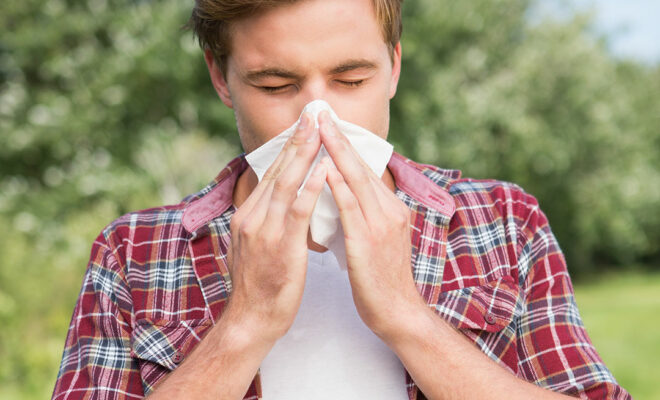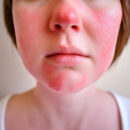Summer Flu

Flu is a highly contagious respiratory infection caused by the influenza virus. The virus causes seasonal outbreaks of respiratory disease that occur in the fall and winter. Despite the seasonality of flu activity, many people may experience flu-like symptoms during the summer months.
Signs and symptoms:
The flu starts suddenly and mainly affects your respiratory system, including your nose, throat, and lungs. Symptoms include:
- runny nose
- Cough
- Constant Sneezing
- Headache and body ache
- Nausea and vomiting
- Diarrhea
- Fever and malaise
- Sore throat
- Chest pain (in severe cases)
- Tiredness
These symptoms are common to many diseases, and exhibiting these symptoms does not necessarily mean that you have the flu, so you should discuss your symptoms with your doctor to rule out other possibilities of these symptoms.
Reasons:
Although there are many reasons, the most common are:
1- Air Conditioners and Fans
Fans and air conditioners can cause rapid cooling in certain parts of the body and allow pathogens to enter the body. Sudden temperature change can cause stress in the body. Entering air-conditioned rooms may increase the risk of catching a cold, as sweat evaporates quickly in a cold environment.
When the effect of the body's own cooling system combines with the air conditioner, the body begins to cool down.
It is also important to be careful during these hours, especially in the evening hours, as the temperature usually drops rapidly.
2- Flu, Cold
The common cold is another respiratory infection caused by various viruses.
There is a lot of overlap between cold and flu symptoms, such as runny or stuffy nose, coughing or sneezing, and sore throat.
However, unlike the flu, cold symptoms develop gradually and are often less severe.
3- COVID-19
COVID-19 infection has some flu-like symptoms, and the disease has been shown to remain active throughout the year. People exposed to the SARS-CoV-2 virus become ill and show several flu-like symptoms, including:
- Fever and malaise
- Fatigue and fatigue
- Headache
- muscle cramps
- Shake
- nausea vomiting
- Diarrhea
- Cough (usually dry)
- chest pain
- difficulty breathing
- Loss of smell and taste
If you exhibit any of the above symptoms, it would be wise to get tested and seek medical attention.
4- Gastroenteritis and food poisoning
Although gastroenteritis is commonly known as “stomach flu,” it has no connection with the flu. Gastroenteritis is usually caused by a group of viruses such as noroviruses or rotaviruses.
Unlike the flu, gastroenteritis symptoms are more focused on your gastrointestinal tract, leading to symptoms such as watery diarrhea and abdominal cramps.
Food poisoning is a condition caused by contaminated food containing bacteria, viruses or other pathogens and their toxins. Most symptoms of the condition are limited to the gastrointestinal tract and do not involve the respiratory system.
5- Pneumonia:
Pneumonia is an infection in the lungs. Cold is one of the symptoms of this disease.
Symptoms that may specifically indicate pneumonia include cough with green or yellow mucus, shortness of breath, and chest pain.
Diagnosis:
The diagnosis is made mainly by the history taken from the patient and the physical examination performed by the doctor.
In some cases, you may need to have blood tests ordered by your doctor for a correct diagnosis.
When should you see your doctor?
If you are experiencing any of the following, you should see your doctor:
- Fever over 103°F (39.4°C)
- Cough containing yellow, green or brown mucus
- Shortness of breath
- Chest pain, especially when breathing
- Dizziness or fainting
- Debris
High risk groups include:
- Children under 5 years old (especially those under 2 years old)
- If you are 18 years of age or younger and taking medications containing aspirin or salicylates
- 65 years and above
- If you are pregnant or have given birth within the last two weeks
- Having a weakened immune system
- Having a serious chronic condition such as heart disease, lung disease, or diabetes
Treatment:
- antiviral drugs
Antiviral medications such as Asoseltamivir (Tamiflu) and Zanamivir (Relenza) can help treat influenza infections.
- Treatments that can be applied at home
- Using over-the-counter medications that reduce pain and fever, such as Nurofen Cold and Flu.
- Using paracetamol and vitamin C supplements to help your immune system.
- Drinking plenty of clear liquids to avoid dehydration.
- Drinking warm liquids, such as tea and broth, to soothe a sore throat
- Taking over-the-counter cough suppressants and decongestants
- doing steam therapy to help open the sinuses and throat
summer blur
Definition:
The flu is a highly contagious respiratory infection caused by the influenza virus. The virus causes seasonal epidemics of respiratory illness that occur during the fall and winter months. Despite the seasonality of influenza activity, many people may experience flu-like symptoms during the summer.
Signs and symptoms:
Flu onset is sudden and it mainly affects your respiratory system including nose, throat, and lungs.
Symptoms include:
- runny nose
- Cough
- Persistent Sneezing
- Headache and body ache
- Nausea and vomiting
- diarrhea
- fever and malaise
- sore throat
- Chest pain (in severe cases)
- Exhaustion and fatigue
These symptoms are common to several diseases, and showing these symptoms doesn't necessarily mean you've contracted the flu. Therefore, you need to discuss your symptoms with your doctor to exclude the other possibilities of these symptoms.
Causes:
There are many causes but the most common ones are:
1- Air conditioners and fans
Fans and air conditioners can lead to rapid cool down in certain parts of the body and may allow pathogens to invade the body. The sudden change of temperature can lead to stress in the body. Entering air-conditioned rooms can increase the risk of catching cold as sweat evaporates immediately in the cooler environment.
The effect of the body's own cooling system is superimposed with the air conditioner, and the body starts cooling down.
It is also important to be careful especially in the evening hours, as the temperature usually falls relatively quickly.
2- Common cold
The common cold is another respiratory infection caused by a variety of viruses.
There's a lot of overlap between the symptoms of the common cold and those of the flu, such as a runny nose or congestion, coughing or sneezing, and sore throat.
However, unlike the flu, the symptoms of the common cold develop gradually and are most often less severe.
3- COVID-19
The COVID-19 infection has several symptoms that resemble the flu, and the disease has been shown to remain active throughout the year. Individuals that have been exposed to the SARS-CoV-2 virus contract the disease and show several flu-like symptoms that include:
- fever & malaise
- Exhaustion & fatigue
- Headache
- muscle cramps
- Chills
- Nausea & vomiting
- diarrhea
- Cough (often dry)
- chest pain
- Discomfort in breathing
- A loss of smell & taste
COVID-19 is an emerging infectious disease due to the ongoing pandemic. If you're showing any of the above symptoms, it would be wise to get tested and seek medical attention.
4- Gastroenteritis and food poisoning
Although gastroenteritis is often referred to as the “stomach flu,” it's not related to influenza. It's often caused by a number of viruses, such as noroviruses or rotaviruses.
In contrast to the flu, the symptoms of gastroenteritis are more focused around your gastrointestinal tract and may include watery diarrhea and abdominal cramps.
Food poisoning is a condition that is caused by contaminated food containing bacteria, viruses, or other pathogens and their toxins. Most of the condition's symptoms are limited to the gastrointestinal tract and do not involve the respiratory system.
5- Pneumonia:
pneumonia is an infection of the lungs and it can also be a complication of the flu. Symptoms to look out for that can point specifically to pneumonia include cough with green or yellow mucus, shortness of breath, and sharp chest pain.
Diagnosis:
Diagnosis is mainly done using patient history and the physical examination carried out by the doctor. In some cases, you may need to do some blood tests ordered by your doctor to look for any other possible disease with similar symptoms.
When do you have to see your doctor?
You should see your doctor if you're experiencing any of the following symptoms:
- fever over 103°F (39.4°C)
- cough that includes yellow, green, or brown mucus
- shortness of breath
- pain in your chest, particularly when breathing in
- light-headedness, dizziness, or passing out
- rash and persistent vomiting
high risk groups include people who:
- are under 5 years old (especially those who are under 2 years old)
- are 18 years old or younger and taking medications containing aspirin or salicylate
- are at least 65 years old
- Are pregnant or have given birth in the past two weeks
- have a weakened immune system
- have a serious chronic condition, such as heart disease, lung disease or diabetes
Treatment:
Antiviral medications
Antiviral medications, such as oseltamivir (Tamiflu) and zanamivir (Relenza) can help treat influenza infections.
home remedies
- Taking over-the-counter medications that reduce pain and a fever such as Nurofen cold and flu. Paracetamol and vitamin c supplements which will help your immune system.
- Avoid sudden change of temperature such as sitting under the air condition for a while after being in the hot weather outside.
- Drinking plenty of clear fluids to stay hydrated
- Drinking warm liquids, such as teas and broths, to soothe a sore throat
- Taking over-the-counter cough suppressants and decongestants
- Using a humidifier to add moisture to indoor air which makes it easier to breathe
- Steam inhalation to help open the sinuses and throat
Dr. Ali Alsahli
Elite Hospital Emergency Service
Contact Us For Appointment:
Telephone line: 0392 444 3548 (ELIT)
Contact Form: https://www.elitenicosia.com/iletisim/

















